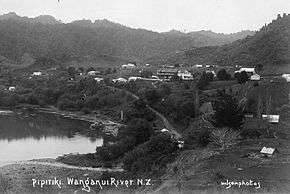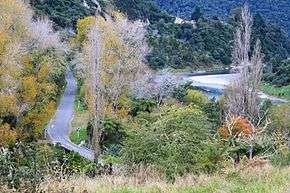Pipiriki


Pipiriki is a settlement on the east bank of the Whanganui River, due west of the town of Raetihi and 79 kilometres (49 mi) upriver from Whanganui; it was originally on the opposite bank.[1] It is the home of Ngāti Kura, a hapū of the Ngāti Ruanui iwi.[1] It is also the location of the Paraweka Marae of the hapū Ngāti Kurawhatia of the iwi Te Āti Haunui-a-Pāpārangi.[2]
In the 1840s Pipiriki was a large stockaded settlement, the second largest on the Whanganui River, consisting of eight pā with a total population of 250–300.[3] Wheat was a major crop from 1848 onward, and the water-powered Kaukore flour mill was built in 1854.[1] In 1865 three redoubts across the river were besieged for several weeks by Pai Mārire warriors.[1]
Pipiriki was an important part of the riverboat trade in the 1890s–1920s, marking a major stop for paddle steamers making the 11-hour journey from Whanganui.[4]
Notable people
- Andy Anderson, riverboat skipper
- Rumatiki Ruth Wright, Māori welfare officer and community leader
References
- 1 2 3 4 Beaglehole, Diana (20 March 2014). "Whanganui places: River Settlements". Te Ara Encyclopedia of New Zealand. Retrieved 17 November 2015.
- ↑ "Paraweka". Maori Maps. Retrieved 18 November 2015.
- ↑ Walton, A. (1994). "Settlement Patterns in the Whanganui River Valley, 1839–1864" (PDF). New Zealand Journal of Archaeology. 16: 123–168.
- ↑ "The Wanganui River". Wanganui Herald. 21 December 1891. p. 2. Retrieved 18 November 2015.
Coordinates: 39°29′S 175°03′E / 39.483°S 175.050°E